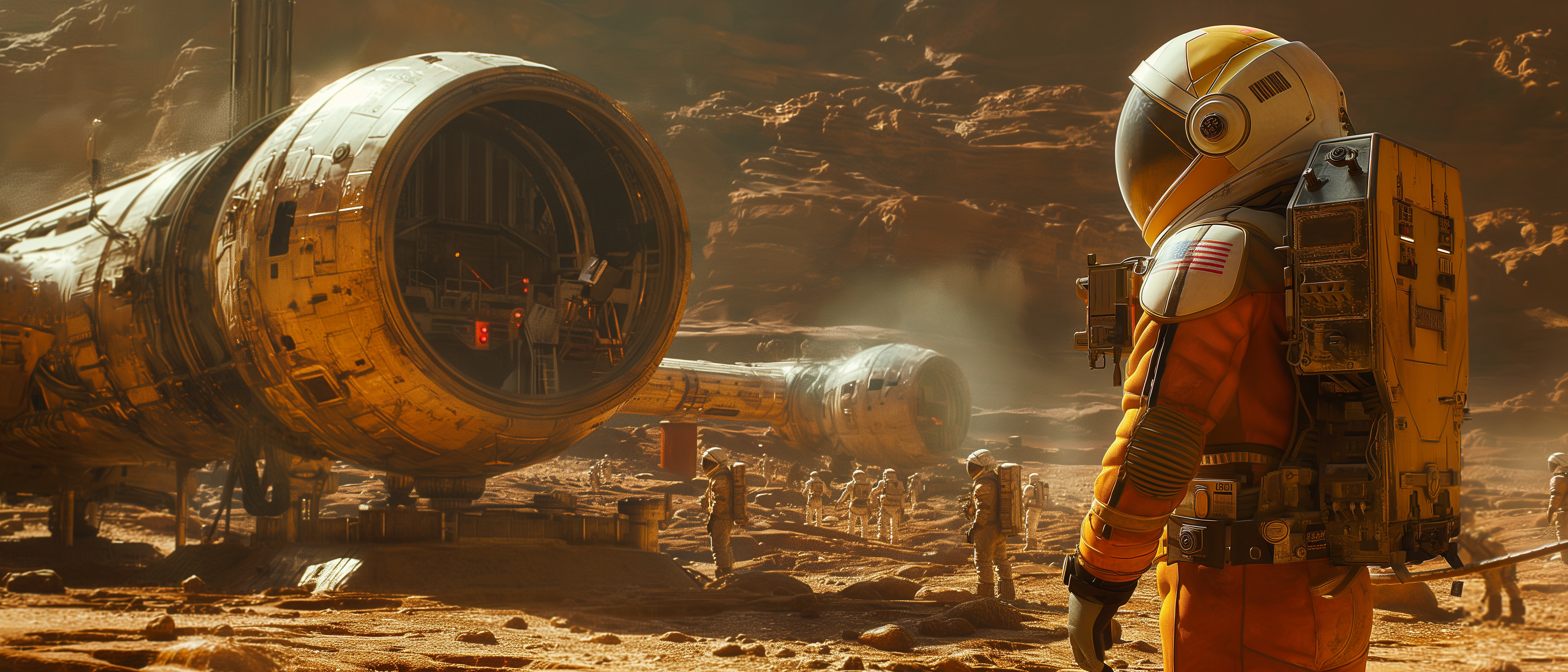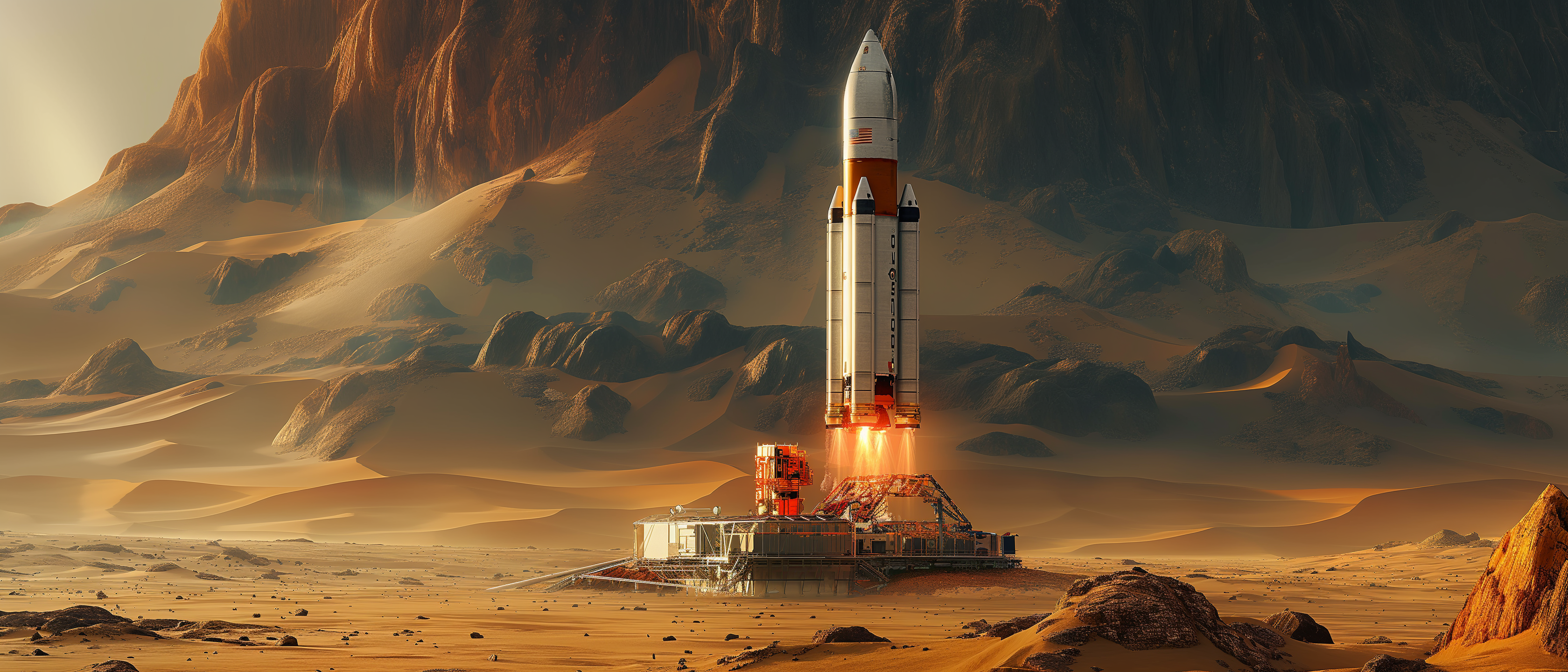Mission to Mars

A New Frontier in Aerospace Exploration
The Mission to Mars represents humanity's boldest leap yet into the cosmos. This mission, spearheaded by an international consortium of space agencies and private aerospace companies, aims to establish a permanent human presence on the Red Planet. This comprehensive overview provides detailed information about the mission's objectives, timeline, technology, and the team that will make this historic journey.
Mission Objectives

Primary Objectives
- Establish a Human Settlement: Create a sustainable habitat for astronauts to live and work on Mars, ensuring long-term survival and productivity.
- Scientific Research: Conduct extensive scientific research to understand Mars' geology, climate, and potential for past or present life.
- Technological Demonstration: Test new technologies for life support, energy production, and resource utilization that will be crucial for future missions and colonization efforts.
Secondary Objectives
- In-Situ Resource Utilization (ISRU): Demonstrate the ability to produce water, oxygen, and fuel from Martian resources, reducing reliance on supplies from Earth.
- Mars Sample Return: Collect and return samples of Martian soil and rock to Earth for detailed analysis, providing unprecedented insights into the planet's history.
- Long-Duration Spaceflight: Study the effects of long-duration spaceflight on the human body and mind, gathering data to improve future interplanetary missions.
Mission Timeline

Pre-Launch Phase (2023-2025)
Development and Testing: Finalize the design and conduct rigorous testing of all mission components, including rockets, habitats, and scientific instruments.
Crew Selection and Training: Select the astronaut team and conduct extensive training to prepare them for the unique challenges of a Mars mission.
Public Engagement: Inform and engage the public about the mission's goals and progress through educational programs, media coverage, and interactive events.
Launch Phase (2026)
Launch Window: The launch is scheduled for a window in mid-2026, optimized for a Hohmann transfer orbit to Mars, ensuring the most efficient use of resources.
Launch Sequence: A multi-stage launch sequence involving several rockets to transport crew, cargo, and habitat modules to Mars.
Mars Transit (2026-2027)
Journey Duration: Approximately 7-9 months of travel time, during which the crew will perform routine system checks, conduct scientific experiments, and maintain their health.
In-Flight Operations: Regular system checks, scientific experiments, and health monitoring to ensure the safety and well-being of the crew during the journey.
Mars Surface Operations (2027-2030)
Landing and Habitat Setup: Landing on Mars and setting up the initial habitat modules, creating a base for long-term exploration and research.
Scientific Exploration: Conducting experiments and exploration missions on the Martian surface, focusing on key scientific questions about the planet.
ISRU Demonstrations: Testing technologies for producing resources from the Martian environment, such as water, oxygen, and fuel.
Return Phase (2030-2031)
Sample Collection and Return: Collecting and packaging Martian samples for return to Earth, ensuring they are preserved for detailed analysis.
Crew Return: Safely returning the crew to Earth, bringing back invaluable scientific data and samples.
Rocket and Spacecraft Details

Rocket: Mars Heavy Lifter
Rocket Engine
Type: Methane/LOX (liquid oxygen) engines, chosen for their efficiency and potential for ISRU on Mars.
Thrust: 7,500 kN per engine, providing the necessary power to escape Earth's gravity and reach Mars.
Specific Impulse: 350 seconds, a measure of the engine's efficiency.
Number of Engines: 28 (first stage), arranged in a cluster for maximum thrust and reliability.
Fuel
Primary Fuel: Liquid methane, selected for its efficiency and ease of storage.
Oxidizer: Liquid oxygen, providing the necessary oxidizer for combustion.
Fuel Capacity: 3,400 metric tons, ensuring sufficient fuel for the journey to Mars.
Rocket Body
Materials: Carbon composite and aluminum-lithium alloy, chosen for their strength and lightweight properties.
Height: 122 meters, making it one of the tallest rockets ever built.
Diameter: 9 meters, providing ample space for cargo and crew modules.
Stages: Two-stage design with reusability features, reducing the cost and environmental impact of the mission.
Technology on Board

Navigation and Control
Autonomous Navigation: AI-driven system for trajectory adjustments and obstacle avoidance, ensuring precise and safe travel to Mars.
Communication: High-gain antennas for continuous contact with Earth, ensuring reliable communication throughout the mission.
Scientific Instruments
Rovers: Two advanced rovers for surface exploration, equipped with cameras, spectrometers, and sampling tools.
Drones: Aerial drones for high-resolution mapping and reconnaissance, providing a new perspective on the Martian landscape.
Medical Facilities
Telemedicine: Real-time communication with medical experts on Earth, enabling remote diagnosis and treatment.
Medical Supplies: Comprehensive kit including surgical tools and emergency equipment, ensuring the crew is prepared for any medical situation.
The Team

Astronauts
- Commander: Dr. Emily Carson: A seasoned astronaut with three previous space missions, providing leadership and experience.
- Pilot: Lt. Mark Evans: Former Air Force pilot and aerospace engineer, responsible for navigation and spacecraft operation.
- Scientist: Dr. Raj Patel: A geologist specializing in planetary sciences, leading the scientific research efforts.
- Engineer: Elena Rodriguez: Expert in spacecraft systems and robotics, ensuring the functionality of all mission components.
- Medical Officer: Dr. Amina Khan: A physician with expertise in space medicine, maintaining the health and well-being of the crew.
- Mission Specialist: Akira Tanaka: Biologist and life support systems engineer, focused on environmental control and life support.
Ground Support
- Mission Control: Located in Houston, Texas, coordinating all mission operations and providing support to the crew.
- Engineering Team: Based in various locations, providing technical support and troubleshooting as needed.
- Scientific Advisors: Experts from NASA, ESA, and other institutions offering guidance on research activities and mission planning.
Rocket Engine and Fuel Details

Engine Specifications
Thrust: Each engine provides a thrust of 7,500 kN, allowing the rocket to achieve the necessary velocity to escape Earth's gravity.
Specific Impulse: With a specific impulse of 350 seconds, the engines are highly efficient, maximizing the distance traveled per unit of fuel.
Fuel Composition
Methane: Chosen for its high energy density and ease of storage, methane is also producible on Mars, aiding in future missions.
Liquid Oxygen (LOX): Used as the oxidizer, LOX is essential for combustion and can be produced from Martian resources.
Rocket Body Structure

Materials
Carbon Composite: Provides a lightweight yet strong structure, essential for reducing launch weight and maximizing payload capacity.
Aluminum-Lithium Alloy: Combines strength and durability, ensuring the rocket can withstand the stresses of launch and space travel.
Dimensions
Height: Standing at 122 meters, the rocket is among the tallest ever built, designed to carry large payloads and crew modules.
Diameter: With a diameter of 9 meters, the rocket accommodates a spacious payload bay for cargo and habitat modules.
Inspirational Quotes

Carl Sagan
"Somewhere, something incredible is waiting to be known."
Neil Armstrong
"That's one small step for man, one giant leap for mankind."
Elon Musk
"When something is important enough, you do it even if the odds are not in your favor."
Conclusion

The Mission to Mars is not just a journey to another planet; it is a giant leap for humanity. This mission will push the boundaries of our knowledge, test our technological prowess, and inspire future generations to look to the stars. Join us as we embark on this historic adventure to make life multi-planetary.